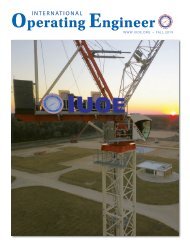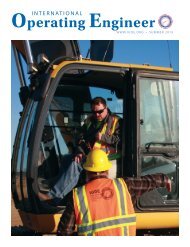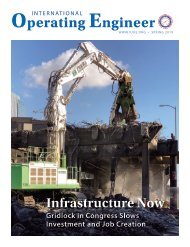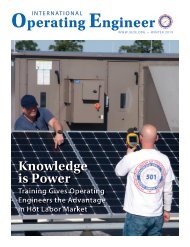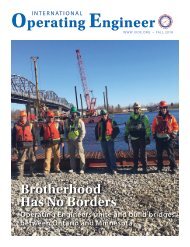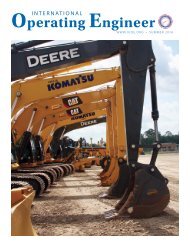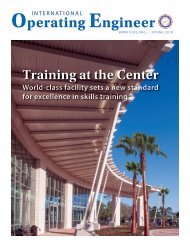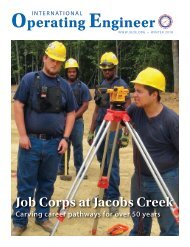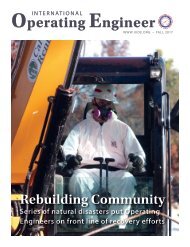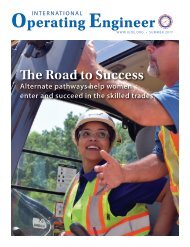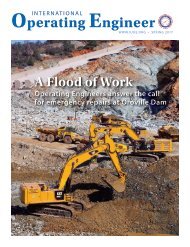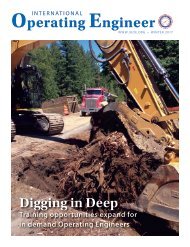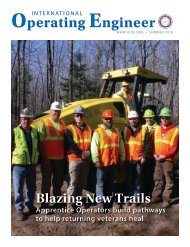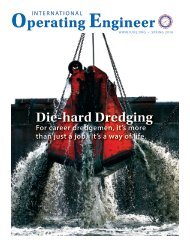125 Years Strong – An IUOE History
Celebrating the 125th Anniversary of the founding of the International Union of Operating Engineers
Celebrating the 125th Anniversary of the founding of the International Union of Operating Engineers
Create successful ePaper yourself
Turn your PDF publications into a flip-book with our unique Google optimized e-Paper software.
INTERNATIONAL UNION OF OPERATING ENGINEERS<br />
of Steam and Operating Engineers (I.U.S.O.E., which would be<br />
renamed to I.U.O.E. in 1927) even began running articles that<br />
contained simple lessons in mathematics “to assist beginners<br />
particularly to secure licenses, and also help them in passing civil<br />
service examinations.” The union chose to publish the articles, titled<br />
“Practical Arithmetic for Engineers and Apprentices,” as requests<br />
from “localities where no license law exists and from apprentice<br />
engineers have become so numerous to this office, asking what<br />
course of study to pursue to fit themselves to pass an examination<br />
for an engineer’s certificate.”<br />
That year, the I.U.S.O.E. was inundated with requests to<br />
establish apprentice locals, about which it announced in the<br />
November 1915 International Steam Engineer, “It is very gratifying<br />
to the General Officers of the I.U.S.O.E. to see the number of<br />
petitions reaching headquarters requesting the organizing of Local<br />
Unions of Apprentice Engineers in the various localities, which<br />
shows beyond all question of doubt the desire of the men of that<br />
calling to become affiliated with our international organization.”<br />
Subsequently, the union issued an initial charter to Apprentice<br />
Local No. 1 of Detroit, an affiliate of that city’s Local No. 5, on<br />
May 18, 1915.<br />
I.U.O.E. instructors work with trainees at the I.T.E.C.<br />
Advancing Apprenticeship to the Forefront<br />
Into the late 1950s, the I.U.O.E. still had little need to<br />
administer standardized apprenticeship programs, especially given<br />
engineers did not require a great deal of math to perform their<br />
jobs. Consequently, the union’s longstanding informal process of<br />
educating apprentices primarily through on-the-job training was<br />
still adequate for preparing those novice members.<br />
But a 1959 ruling by the National Labor Relations Board (N.L.R.B.)<br />
that would affect the hoisting and portable branch of the I.U.O.E.<br />
essentially forced the union to formally engage in apprenticeship<br />
training. In the decision, the N.L.R.B. declared that the operation of<br />
construction machinery was a “service trade” instead of a “skilled<br />
craft” because no federal apprenticeship program for operating<br />
engineers existed at the time and, therefore, they essentially did not<br />
possess skills that required excessive training.<br />
“While we believe that these rulings are wrong, they are<br />
nevertheless effective as an obstacle to our progress. They<br />
stand in the way of our ability to carve out our proper bargaining<br />
units from larger bodies of employees and severely hinder our<br />
organizational activities,” General President Joseph J. Delaney<br />
declared to the I.U.O.E. 26 th Convention on April 11, 1960. “The<br />
only way to overcome this problem is through the development<br />
and promotion of recognized apprenticeship training programs.”<br />
Local No. 428 of Arizona established the union’s first<br />
negotiated joint-labor-management apprenticeship program for<br />
operating engineers in 1959 <strong>–</strong> which was the first to apply a<br />
set of recommended apprenticeship standards <strong>–</strong> when its new<br />
contract set up a joint apprenticeship fund financed by employer<br />
A drilling class at Local 150 in Chicago.<br />
contributions. The fund would develop and maintain a federally<br />
sanctioned apprenticeship program that included 6,000 hours of<br />
schooling through standardized classroom instruction and on-thejob<br />
training for grading- and paving-equipment operators; heavyduty<br />
mechanics and repairmen; universal-equipment operator;<br />
and plant-equipment operators.<br />
As the I.U.O.E. continued to develop its training efforts on<br />
an international level, in 1961 it assigned New York Local<br />
No. 15 Business Agent Reese Hammond as director of the<br />
union’s Department of Research and Organization and charged<br />
him with formulating its education and training programs.<br />
The union then renegotiated its agreement with the National<br />
Constructors’ Association (NCA) in 1962 to include a new article<br />
through which the two parties agreed to establish a National<br />
Joint Apprenticeship Committee composed of<br />
three association members and three union<br />
members “to consider and develop national<br />
standards for apprenticeship for the trade<br />
of operating engineer.” After the Associated<br />
General Contractors joined the committee, the<br />
I.U.O.E. and its employers adopted national<br />
apprenticeship standards at a March 1963<br />
meeting, which were subsequently approved by<br />
the Federal Committee on Apprenticeship.<br />
As the I.U.O.E.’s education and training<br />
director, Brother Hammond also negotiated with<br />
higher-education institutions, including community<br />
colleges, to allow apprentices to receive academic<br />
credit for their union-sponsored instruction.<br />
Between 1964 and 1968, the I.U.O.E.<br />
developed the concept of “continuous<br />
total training,” including pre-apprenticeship,<br />
apprenticeship and upgrade courses for<br />
journeyman-level members, and the union<br />
also began participating in Job Corps to help<br />
A paving class at Local 150.<br />
provide individuals in need with career skills. The<br />
international began assisting locals in earnest in<br />
1966 with developing apprentice and training<br />
programs, as well as training standards and<br />
performance specifications.<br />
As a result of those efforts, by 1968 the<br />
union’s hoisting and portable locals were annually<br />
disbursing $5 million among the apprenticeship<br />
and training programs of 38 locals that were<br />
educating more than 2,000 total apprentices.<br />
What’s more, between 1966 and 1982, the U.S.<br />
Department of Labor awarded over $16 million<br />
in government contracts to I.U.O.E. employment,<br />
training and research initiatives under the union’s<br />
National Training Program.<br />
The union had more than 7,300 registered<br />
apprentices in its hoisting training programs<br />
in 1980, although that number dramatically<br />
dropped to just over 4,000 in 1986 in the wake of a poor national<br />
economy and increased non-union competition. From that time<br />
into 1992, however, the figure slightly rose to more than 4,670<br />
enrolled in programs operated by 75 locals.<br />
The development of training programs for I.U.O.E. stationary<br />
locals was similar to that of the union’s hoisting and portable locals,<br />
if not as rapid. The union’s Committee on Stationary Engineers first<br />
worked to establish a National Stationary Apprenticeship Program<br />
with employing contractors beginning in early 1973, the result<br />
of which was adoption of new national standards for stationaryengineer<br />
apprenticeship training that September. But into the 1990s,<br />
formal training for stationary apprentices was not as widespread as it<br />
was for the union’s hoisting and portable apprentices.<br />
LABOR OMNIA VINCIT<br />
WORK CONQUERS ALL



